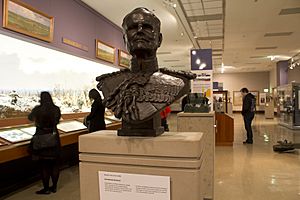Barbara Tribe facts for kids
Quick facts for kids
Barbara Tribe
FRBS
|
|
|---|---|
| Born | 20 June 1913 Sydney, Australia
|
| Died | 21 October 2000 (aged 87) Penzance, England
|
| Resting place | Paul Cemetery, Penzance |
| Education | East Sydney Technical College |
| Known for | Sculpture, painting, printmaking |
| Awards | Jean Masson Davidson Medal from the Society of Portrait Sculptors |
Barbara Tribe (born in 1913, died in 2000) was a talented artist from Australia. She spent most of her life creating art in Cornwall, England. Barbara was known as an important artist of the 1900s. She was especially famous for her portraits, which she created using both painting and sculpture.
Contents
Barbara Tribe's Life Story
Barbara Tribe was born in Edgecliff, a suburb of Sydney, Australia. Her parents were from England. In 1935, Barbara won a special scholarship that let her travel. This scholarship allowed her to move to England. She lived and worked there for the rest of her life.
In 1947, Barbara married John Singleman. He was an architect and also worked with pottery. They bought an old building in Sheffield, Cornwall that used to be a Sunday School. They called it 'The Studio' and moved in soon after.
Learning to Be an Artist
Barbara started her art studies at the Sydney Technical College in Australia. She was only 15 years old when she began in 1928. She studied there until 1933.
After moving to England, Barbara continued her education. She first went to the Kennington City & Guilds School of Art in 1936. Later, she was accepted into the Regent Street Polytechnic School of Art.
Her Art and Career

Barbara Tribe's art was greatly shaped by her travels and experiences. At Sydney Technical College, she learned from a sculptor named Raynor Hoff. His style really influenced her early work, especially her sculptures of people.
After finishing her diploma, Barbara worked as Hoff's helper. She even helped him with the Hyde Park war memorial in Sydney. From 1931 to 1934, Barbara often showed her art with the Society of Artists. She had her very first solo art show in 1934.
In the 1930s, Barbara and another Australian artist, Jean Elwing, convinced a big store called Selfridges to give them studio space. The store even hosted parties for the young artist.
During the Second World War, Barbara worked to record important historic buildings. This helped protect them. After the war, she started teaching art part-time at the Penzance School of Art. She taught there for over 40 years, finally retiring in 1988. Barbara was also a member of the Newlyn Society of Artists and the St Ives Society of Artists.
Important Artworks and Commissions
In 1943, Australia House, London asked Barbara to create sculptures. She made busts (sculptures of heads and shoulders) of seven important Australian airmen. In the 1940s, she also began showing her work at famous places like the Royal Academy of Arts. She also exhibited at the Royal Society of British Sculptors.
Barbara created a piece called Embryo. This artwork was shown in a famous exhibition in 1953. The exhibition was called The Unknown Political Prisoner.
Awards and Recognition
Barbara Tribe received many awards during her life. These awards showed how much her art was appreciated:
- Bronze medal for Sculpture, Sydney Technical College, 1933
- New South Wales Travelling Art Scholarship, 1935. Barbara was the first woman ever to win this award!
- Jean Masson Davidson Medal, Society of Portrait Sculptors, London, 1998
Where to See Her Art
Barbara Tribe's art can be found in several public collections. This means her works are kept in museums and galleries for everyone to see. Here are a few examples:
- Bust of Frank McIlwraith (1937) at the National Portrait Gallery (Australia) in Canberra, Australia.
- Dang, Child of Thailand (1971) at the Doncaster Museum and Art Gallery in Yorkshire, England.
- Dr Lloyd Rees (1966) at the Art Gallery of New South Wales in Sydney, Australia.
- Kookaburra (1987) at the Royal West of England Academy in Bristol, England.
- Medusa (1931) at the National Gallery of Victoria in Melbourne, Australia.
Barbara Tribe's Legacy
Barbara Tribe wanted her art to keep helping others even after she was gone. In her will, she asked for some of her artworks to be sold. The money from these sales helped create the Barbara Tribe Foundation. This foundation is managed by the Art Gallery of New South Wales. Its main goal is to support and promote sculpture in Australia.
There is also a special collection of documents and information about Barbara Tribe. It is kept at the National Art Archive, which is part of the Art Gallery of New South Wales. This archive helps people learn more about her life and work.

